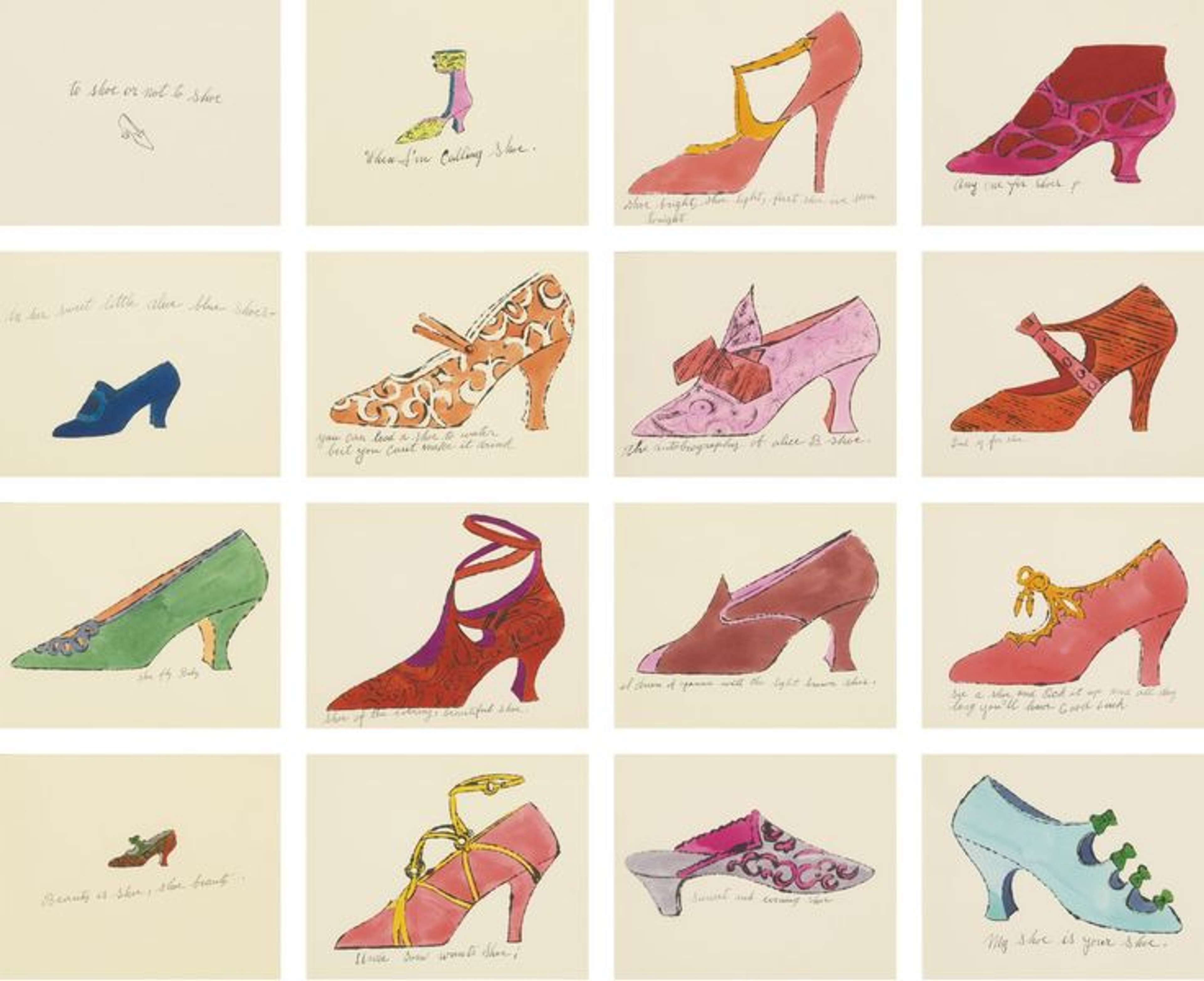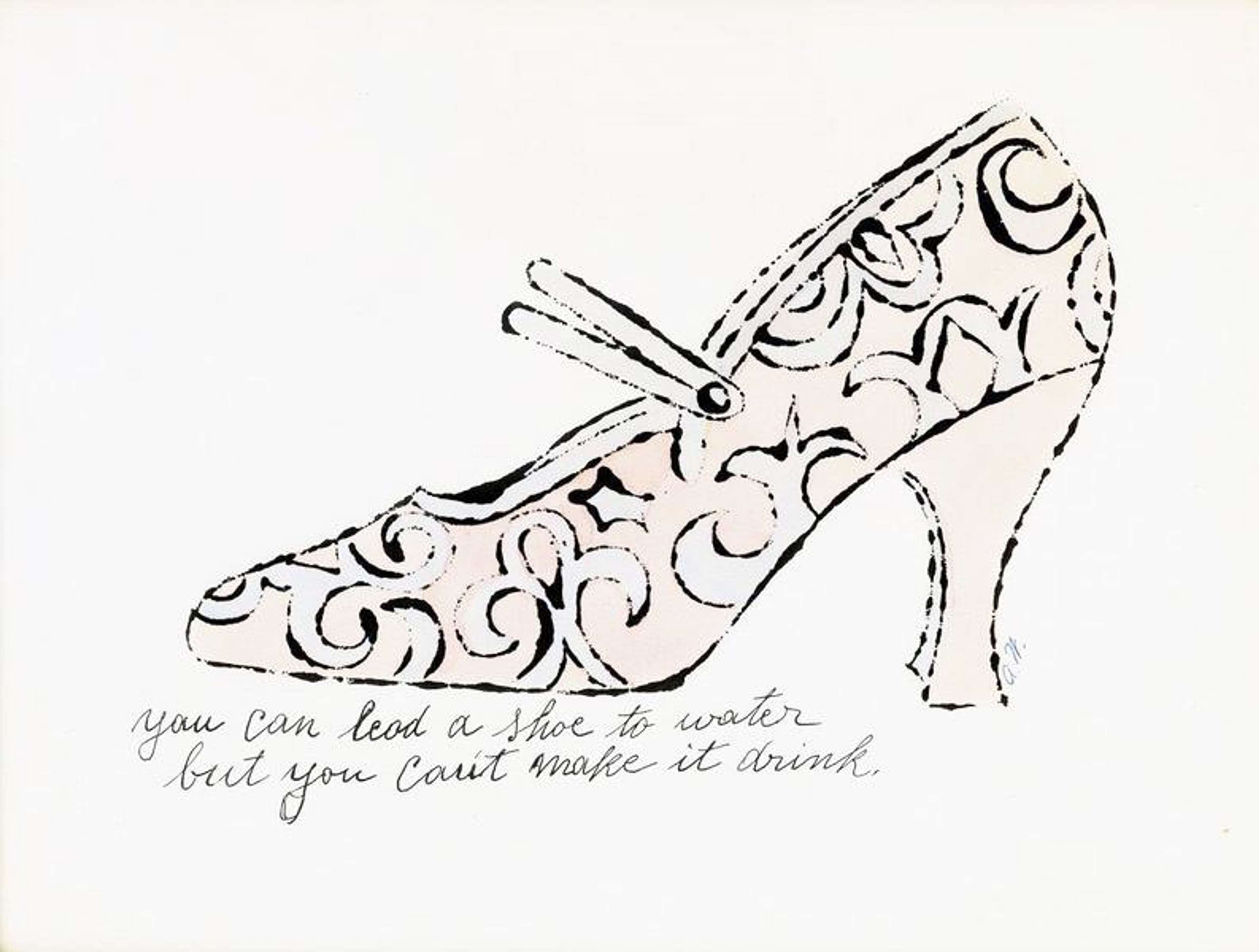10 Facts About Andy Warhol's Diamond Dust Shoes

 Diamond Dust Shoes (F. & S. II.253) © Andy Warhol 1980
Diamond Dust Shoes (F. & S. II.253) © Andy Warhol 1980
Interested in buying or selling
Andy Warhol?

Andy Warhol
487 works
Voguish and camp, Andy Warhol's Diamond Dust Shoes is testament to his fascination with the world of fashion. The high-heeled shoe is one of Warhol's most repeated subjects, and one which launched him to fame as both fashion illustrator and Pop Art kingpin.
The series was created as an ad campaign for Warhol's friend and fashion designer Roy Halston Frowick.
 Diamond Dust Shoes (F. & S. II.254) © Andy Warhol 1980
Diamond Dust Shoes (F. & S. II.254) © Andy Warhol 1980Warhol's Diamond Dust Shoes was the result of a commission from his friend and acclaimed fashion designer, Roy Halston Frowick, also known as 'Halston'. Throughout his career, Warhol captured Halston's portrait, signifying the close relationship between the pair. Diamond Dust Shoes is just one instance in which the fashion designer and the artist inspired one another.
Diamond Dust Shoes was created with real diamond dust particles.
 Diamond Dust Shoes (F. & S. II. 257) © Andy Warhol 1980
Diamond Dust Shoes (F. & S. II. 257) © Andy Warhol 1980Made in collaboration with Warhol's master print maker, Rupert Jasen Smith, Diamond Dust Shoes incorporated real diamond dust particles in the printing process - hence the name of this extravagant series. This was the first time Warhol had printed with this method, and gave the prints a relief surface with reflective properties. Not only did this printing method give the shoes a three-dimensional appeal, but it also added to the luxe materiality of the designer footwear.
The series wasn't the first time Warhol represented women's shoes.
 La Recherche Du Shoe Perdu © Andy Warhol 1955
La Recherche Du Shoe Perdu © Andy Warhol 1955Shoes are a recurring motif in the oeuvre of Andy Warhol. His series La Recherche Du Shoe Perdu, executed in 1955, is an example of Warhol's fascination with the subject of women's footwear in his formative years as an artist. In the same year, Warhol began work with the I. Miller shoe company, and produced weekly shoe drawings for the relaunch of the company, conveying the distinct personality of each heeled shoe.
Warhol's artistic career was grounded in fashion.
 Blackglama (Judy Garland) (F. & S. II.351) © Andy Warhol 1985
Blackglama (Judy Garland) (F. & S. II.351) © Andy Warhol 1985After he graduated from the Carnegie Institute of Technology in 1949, with a degree in Pictorial Design, Warhol moved to New York to find work in his craft. In the 1950s, Warhol established himself as an extremely successful illustrator, with a particular draw towards fashion. Throughout this early period in his career, Warhol created colourful illustrations for Harper's Bazaar, Tiffany & Co., and Glamour - producing several shoe drawings for the latter. Warhol's fascination with fashion was enduring, and shaped a lot of his commercially-inspired oeuvre.
The shoe was a career-defining subject for Warhol.
 Untitled (from La Recherche Du Shoe Perdu) © Andy Warhol 1955
Untitled (from La Recherche Du Shoe Perdu) © Andy Warhol 1955From the onset of his career as an illustrator, the shoe had a particular magnetism for Warhol. In fact, he was so preoccupied by the subject that he sent one of his shoe drawings - simply titled Shoe - to the Museum of Modern Art (MoMA) in 1956. Shockingly, the work was rejected by MoMA, who requested Warhol to retrieve it - likely a decision regretted after Warhol established himself as the founding father of Pop Art.
The series encapsulated the excessive spirit of the 1970s/80s and the glamorous night culture of Studio 54.
 Diamond Dust Shoes (F. & S. II.253) © Andy Warhol 1980
Diamond Dust Shoes (F. & S. II.253) © Andy Warhol 1980At the close of the 1970s, and throughout the 1980s, Warhol found himself at the centre of an outrageous and eclectic social scene in New York. Both Warhol and Halston frequented the legendary Studio 54, and spent dizzying nights here with the likes of Jerry Hall, Liza Minnelli, and Grace Jones. The shoes captured in Diamond Dust Shoes look as though they could be lit by the coloured beams of the nightclub, seemingly strewn on the floor in a drunken daze.
Diamond Dust Shoes is testament to Warhol's fascination with self-fashioning and drag.
 Self-Portrait In Drag © Andy Warhol 1981 © Sotheby's
Self-Portrait In Drag © Andy Warhol 1981 © Sotheby'sThe stiletto is, perhaps, a drag queen's ultimate accessory. It is hardly surprising that Warhol should be so drawn to the high-heeled shoe, given his own engagement with queer culture. Inspired by Marcel Duchamp's drag alter-ego, Rrose Sélavy, Warhol captured himself in drag later in his career. Diamond Dust Shoes is, therefore, not only an homage to the world of couture, but also the creative freedom of queer self-fashioning.
The series was created with Warhol' iconic Polaroid photograph technique.
 Diamond Dust Shoes (F. & S. II. 255) by Andy Warhol
Diamond Dust Shoes (F. & S. II. 255) by Andy WarholAfter Warhol accepted the commission for Diamond Dust Shoes, Halston sent his boyfriend, Victor Hugo, to Warhol's studio with a box of his shoes. Warhol's chief art assistance, Ronnie Cutrone, emptied the box of shoes onto the floor to inspect the loot. The accidental arrangement of the shoes intrigued Warhol, who snapped them in this haphazard display, and these spontaneous Polaroids became the basis of the series.
Diamond Dust Shoes speaks to Warhol's fascination with the commodity and consumer culture.
 Diamond Dust Shoes (F. & S. II.256) © Andy Warhol 1980
Diamond Dust Shoes (F. & S. II.256) © Andy Warhol 1980Each individual shoe captured by Warhol in this series is imbued with a unique character, or personality. Through his application of colour during the printing process, and the arrangement of the shoes to show off their detailing, Warhol gives them an almost life-like quality. Each shoe leads the viewer to question who might have worn it. This invigorating approach to the mundane commodity is something which defined Warhol's entire oeuvre, and underscores the entire genre of Pop Art.
Warhol was known as "the Leonardo da Vinci of the shoe trade".
 You Can Lead A Shoe To Water But You Can’t Make It Drink © Andy Warhol 1950
You Can Lead A Shoe To Water But You Can’t Make It Drink © Andy Warhol 1950There is a cyclical appeal to Warhol's Diamond Dust Shoes series, seeing as this was a return to the subject which launched him to early success. From the onset of his career, the shoe became one of Warhol's favoured subjects, and one that he truly mastered across illustration, painting, photography, and printing. Warhol mused after the creation of Diamond Dust Shoes: "I'm doing shoes because I'm going back to my roots. In fact, I think maybe I should do nothing but shoes from now on."